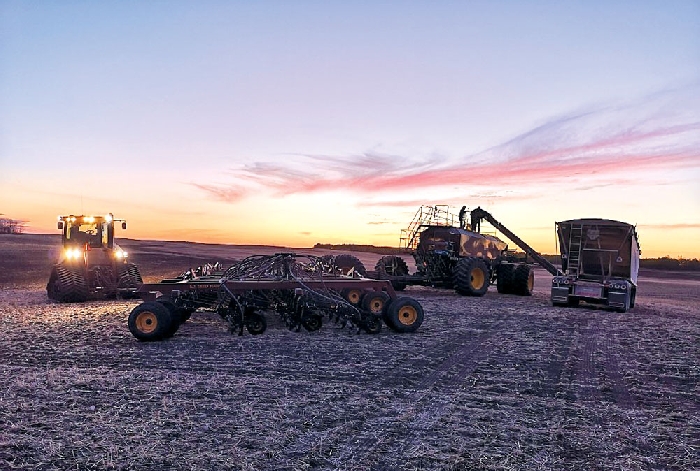2019 crop is in the ground
June 4, 2019, 1:46 am
Kara Kinna


Producers are nearing the spring seeding finish line in Southeast Saskatchewan thanks to continued good seeding conditions.
Matt Ross, an agronomist with Lincoln Farm Supply, says rain will be needed in the next few weeks in the local area, but a shot of rain on the weekend of May 25 has helped the area a lot, and conditions were good for seeding.
“Moisture was adequate for seeding,” he says. “I think guys are hoping we get some rain. That rain we got last week was well timed and we are going to need some more, but I would say we are pretty fortunate compared to most areas. In our area, moisture is pretty good, and with that bit of rain a week ago, most guys were done or nearly done seeding.”
“We are going to need some rain here in a week or two, but all things considered it’s almost ideal right now.
“It was well timed, that rain, and it was needed.”
“You don’t have to go very far north where it’s quite a bit drier.”
Ross says crops in the local area should be okay for moisture for a few weeks.
However if warm and dry weather persists, problems will come with it.
“With this warmer weather now there are some flea beetles in the canola, but the canola is starting to grow with the warm weather, so hopefully we don’t have too much issue with that, but in spots there may have to be some spraying for flea beetles,” he says.
“You’ll never know if you’ll have grasshoppers, but that’s quite a way off.
“I think all of our customers are done seeding now. It was kind of a nice quick seeding and it’s been a nice start, and hopefully keeps it up.”
Mark McCorriston is a local farmer who has land ranging from the Rocanville area down to the Maryfield area. He says the dry weather was great for seeding, but is now a concern for him.
“I’m pretty concerned. I have land spread out all the way from the old potash mine at Rocanville almost to Maryfield and the land at the old potash mine is really, really dry,” he says. “It’s only got two and a half tenths of rain this year, and then I have land right around the community of Rocanville by the golf course. It’s kind of adequate. It got one shot of almost a half inch about a week ago, and then I got a couple more tenths the other day. At Moosomin we’re just barely holding on, and then if you get south of Fleming going towards Maryfield, it’s actually not too bad at all. It seems the farther south you go, the better it is.
“It’s just the way the rains come. They seem to be pushing up from the States, I watch them on the radar, and they just kind of touch our area but we just don’t get quite enough.
“I’m definitely concerned because it’s hot and dry now, and windy, and we had a light frost on the canola. It hurt the plants, not to the point of reseeding, but they are struggling and it’s hot and dry.
“And then we are getting flea beetle pressure. Once the wind drops I plan to start spraying the headlands, the outside around the fields, to keep the flea beetles from migrating onto my land.
“The cereals are holding on but my canola is in distress. We need an inch of rain. It’s not a very good situation, and then grain prices are at an all-time low for the last three years. It’s not as promising in the ag industry as it has been in the past.
“Ideally, and especially up by the potash mine, if we could get some rain right now, it would be perfect. I have pasture land for cattle and grain land up by the potash mine, and they are both in dire straights.
“But as you get near Fleming and close to the Pipestone Valley, we’re probably okay for a week to ten days.
“I really feel bad for the people farming near Rocanville going north if that’s where all their land base is. I’m lucky I’m spread out.
“In the dry years, the flea beetle pressure is definitely a lot stronger because the canola plants are slow to get going, and then the flea beetles can get on top of them.
“And I feel that we are around the corner from having problems with grasshoppers. I grew up in the ‘80s, and we are onto year number three of drier weather. I would think grasshoppers would definitely be a concern by the end of the year.”
Ninety-four per cent of the crop is now seeded, up from 71 per cent last week and well ahead of the five-year (2014-2018) average of 86 per cent for this time of year.
Rainfall last week ranged from nil to 16 mm in the Maryfield area.
The Carnduff area reported 11 mm, the Kisbey, Whitewood, Broadview, Grenfell and Odessa areas 4 mm. The Regina and Pense areas received 10 mm, 13 mm in the Moose Jaw area and 12 mm in the Glenavon area. The Indian Head area has received the most precipitation since April 1 (64 mm).
Despite the rainfall, topsoil moisture conditions have continued to deteriorate due to strong winds and warm temperatures.
Many areas remain in need of significant rain.
Cropland topsoil moisture is rated as 39 per cent adequate, 52 per cent short and 9 per cent very short. Hay land and pasture topsoil moisture is rated as 18 per cent adequate, 62 per cent short and 20 per cent very short.
Rain will be needed soon to help crops germinate and emerge and for pastures to grow.
Pasture conditions are rated as nine per cent good, 47 per cent fair, 35 per cent poor and nine per cent very poor.
Overall, crops are normal to behind in their developmental stage for this time of the year.
Emergence has been delayed in many areas by cool weather and dry field conditions. The majority of crop damage this past week was caused by lack of moisture, frost and strong winds, with flea beetles causing damage in canola crops. Some canola fields are being re-seeded due to frost damage.
Across the province, 92 per cent of the crop is now seeded, up from 73 per cent last week and well ahead of the five-year average (2014-18) of 83 per cent for this time of year.
The southwest region is the most advanced, with 96 per cent of the crop in the ground. Ninety-four per cent is seeded in the southeast, 91 per cent of the crop is seeded in the east central region, 92 per cent in the west central region, 90 per cent in the north east and 87 per cent in the north west.



































